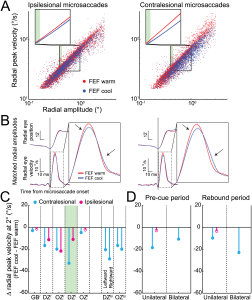As part of an exciting collaboration with the lab of Brian Corneil at the University of Western Ontario in Canada, our lab has been investigating neural mechanisms for microsaccade generation in cortex. We just published an article in PLOS Biology describing some of the results of this interesting collaboration.

In this study, we exploited the technique of reversible cryogenic inactivation of neural activity to investigate the role of the cortical frontal eye fields in microsaccade generation. To date, our knowledge of microsaccade generation was restricted to sub-cortical structures. However, in this study, we found that the frontal eye fields in cortex play a causal role in microsaccade generation.
We found that reversible inactivation of the frontal eye fields, whether unilaterally (i.e. affecting only one visual hemifield) or bilaterally (i.e. affecting both visual hemifields), had a dramatic impact on microsaccade kinematics, as well as on the deployment of microsaccades during peripheral cueing paradigms (as in tasks studying covert visual attention).
Given our previous results on the potentially important roles that microsaccades can play in a variety of visual and attentional tasks, these tiny eye movements may be strategically deployed as part of our general oculomotor repertoire. Our present results on frontal eye fields are particularly interesting in this regard, because they provide a possible neural substrate for how cognitive processes can influence the strategic deployment of microsaccades. Our results also constitute the first direct evidence, to our knowledge, for the contribution of any cortical area to microsaccade generation.
